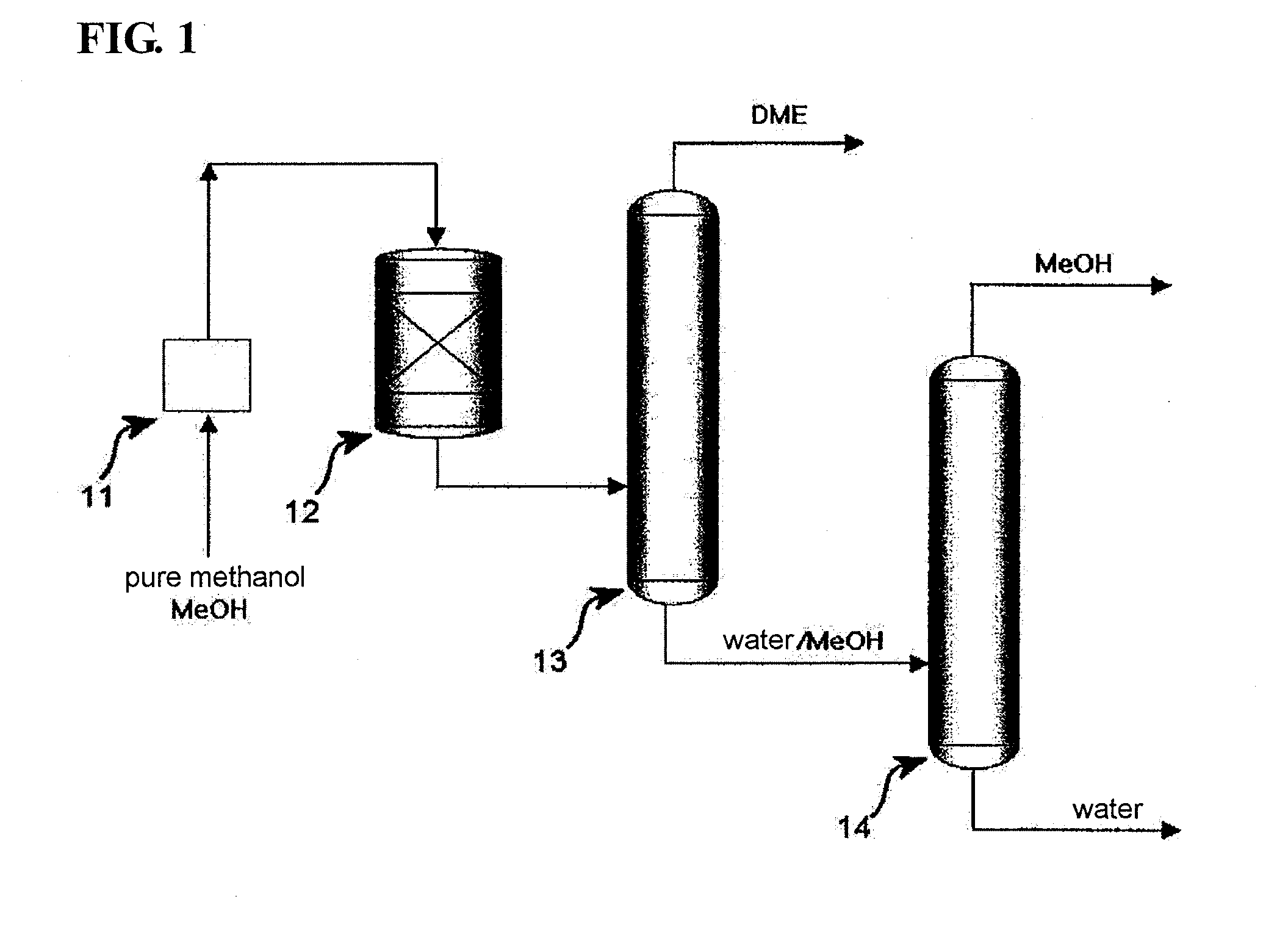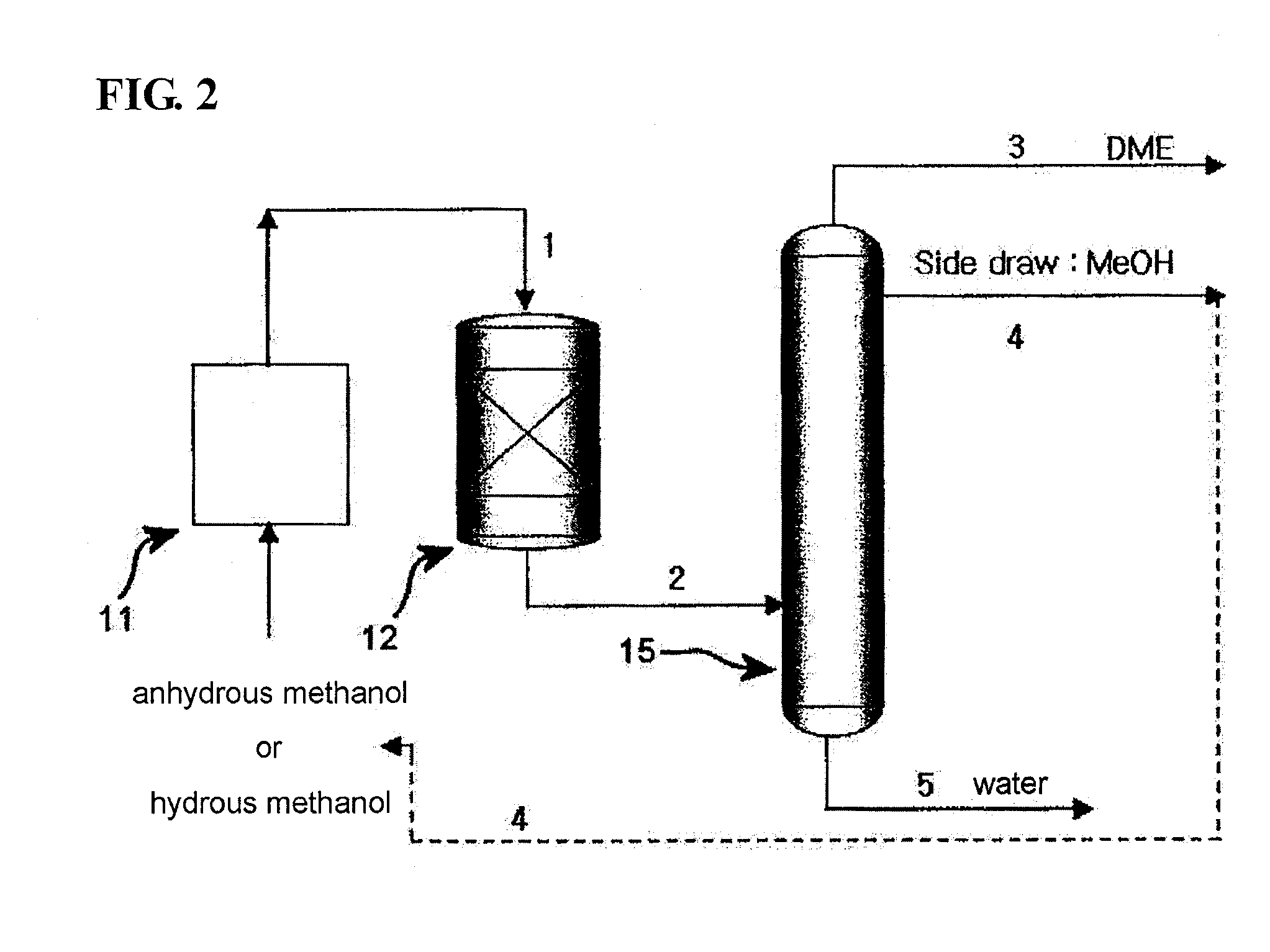Process for preparing dimethyl ether
a dimethyl ether and ether technology, applied in the field of dimethyl ether preparation, can solve the problems of deteriorating catalytic activity, difficult to reproduce the catalyst, and decreasing the number of activation sites of the catalyst, so as to reduce the size of the apparatus, and efficiently cope with the change
- Summary
- Abstract
- Description
- Claims
- Application Information
AI Technical Summary
Benefits of technology
Problems solved by technology
Method used
Image
Examples
example 1
[0047]300 liters of an NaPZSM-5 catalyst was loaded into a fixed-bed reactor. In this state, the catalyst was pre-treated at 400° C. for 1 hour while nitrogen was supplied at a flow rate of 18.5 Nm3 / min, after which the temperature of the reactor was set to 250° C. Subsequently, hydrous methanol containing 20 mol % of water was supplied as a feedstock under conditions of reaction pressure of 10 atm and reaction temperature of 250° C., and was combined with a recycling stream and thus passed through the catalyst bed at LHSV of 5˜10 h−1.
[0048]The reaction product (DME, water, unreacted MeOH) discharged from the reactor was transferred into a single separation column. The operation conditions of the single separation column were set as follows, that is, the number of total trays was 56, the pressure of the top tray was about 10 kg / cm2, the temperature at the bottom of the column was about 184° C., and the temperature at the top of the column was about 48° C. After the feed-in to tray 3...
example 2
[0050]300 liters of an NaPZSM-5 catalyst was loaded into a fixed bed reactor. In this state, the catalyst was pre-treated at 400° C. for 1 hour while nitrogen was supplied at a flow rate of 18.5 Nm3 / min, after which the temperature of the reactor was set to 250° C. Subsequently, hydrous methanol containing 20 mol % of water was supplied as a feedstock under conditions of reaction pressure of 10 atm and reaction temperature of 250° C., and was combined with a recycling stream, and thus passed through the catalyst bed at LHSV of 5˜10 h−1.
[0051]The reaction product (DME, water, unreacted MeOH), discharged from the reactor, was transferred into a single separation column. The operation conditions of the single separation column were set as follows, that is, the number of total frays was 56, the pressure of the top tray was about 10 kg / cm2, the temperature at the bottom of the column was about 184° C., and the temperature at the top of the column was about 48° C. After the feed-in to fra...
example 3
[0053]300 liters of an NaPZSM-5 catalyst was loaded into a fixed-bed reactor. In this state, the catalyst was pre-treated at 400° C. for 1 hour while nitrogen was supplied at a flow rate of 18.5 Nm3 / min, after which the temperature of the reactor was set to 250° C. Subsequently, hydrous methanol containing 20 mol % of water was supplied as a feedstock under conditions of reaction pressure of 10 atm and reaction temperature of 250° C., and was combined with a recycling stream and thus passed through the catalyst bed at LHSV of 5˜10 h−1.
[0054]The reaction product (DME, water, unreacted MeOH, 10 kg / cm2, near 300° C.), discharged from the reactor, was in a gaseous phase of about 170˜180° C. after heat exchange, and was fed into a flash drum before being transferred into a single separation column. Through the flash drum, the temperature was decreased to about 153° C., and partial condensation occurred. About 20% by the mass ratio of the flash drum feed was condensed to a liquid phase (w...
PUM
| Property | Measurement | Unit |
|---|---|---|
| pressure | aaaaa | aaaaa |
| temperature | aaaaa | aaaaa |
| hydrophobic | aaaaa | aaaaa |
Abstract
Description
Claims
Application Information
 Login to View More
Login to View More - R&D
- Intellectual Property
- Life Sciences
- Materials
- Tech Scout
- Unparalleled Data Quality
- Higher Quality Content
- 60% Fewer Hallucinations
Browse by: Latest US Patents, China's latest patents, Technical Efficacy Thesaurus, Application Domain, Technology Topic, Popular Technical Reports.
© 2025 PatSnap. All rights reserved.Legal|Privacy policy|Modern Slavery Act Transparency Statement|Sitemap|About US| Contact US: help@patsnap.com



